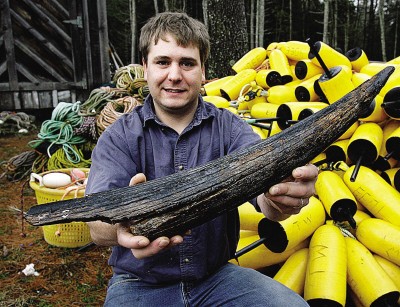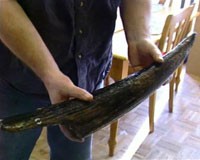
January 11, 2007

This mastodon (Mammut americanum) is the life-sized bronze representation at the Indiana University-Purdue University Fort Wayne, the home of the “Mastodons.”
As you will recall, on the 8th, you first read here about the “Mystery Tusk.” Now comes a “confirmed” answer. Or is it? Therein lies the tale behind the splash on the television screen.
The video is running on the local news this morning and WCSH-6 has run a backup item on their website by Peter Weyl. The mystery tusk was discovered by Tim Winchenbach of Cushing. He found it in a scallop net brought up from the Georges Bank. The tusk is allegedly from a mastodon, not a wooly mammoth. Well, at least, the artifact is not being pinned on a circus elephant as was done in the 1950s, with a previous find.

As a side note, I see that Mr. Winchenbach’s name literally may be translated from German as “hauled from a brook.”
What is the source of the rather definitely mastodon verdict? Apparently, with cameras rolling, a staff member of the Maine State Museum looked in some books and said so because the teeth of mastodons have been found out to sea within several hundreds of miles near this find! No internal structural analysis, no radio carbon-dating, so far. Nope. None. But because only mastodons fossils have been found out to sea off the Coast of Maine, shazam, it must be a mastodon.

As WCSH puts it:
A paleontologist at the Maine State Museum says the tusk came from a mastodon…Dr. Paula Work confirmed that it is, indeed, part of a pre-historic tusk. But she says it actually came from a mastodon, which was slightly smaller than the wooly mammoth….
Doctor Work says mastodons roamed the area that is now covered by North Atlantic waters 13,000 years ago, although the tusk could be much older.
“We can actually start to map out where these finds are and we may very well find out the mastodons were right over here on Georges Bank that must have been a forested area,” said Dr. Work.
Okay, okay, it probably is from a mastodon. But what if it is a new species of something with tusks, a brand new find of a mammoth there, a giant walrus, or a new subspecies of mastodon that should be named after Winchenbach? Perhaps my natural cryptozoological skepticism is coming out with regard to this story, as a cautionary tale, but this latest bit of news shows some intriguing tendencies to go for the easy answer, if you ask me.
Tim and Michelle Winchenbach, at least, is interested in more answers.
“I’d like to have it carbon dated so I know how old it is. Because they don’t really know how long ago it was that was dry land and how far back the dry land was there,” said [Tim] Winchenbach.
Well, at least one other mystery find not heard about before was solved. I saw the images of it on WCSH-6 this morning, and the paleontologist is on target about this one:

The Winchenbachs also brought another artifact, a huge tooth that was found by Tim’s brother Anthony last spring. Doctor Work positively identified it as a mastodon tooth.
Poor Paula Work. She’s probably not been called “Doctor Work” so many times in one news article.
So where are we? One verdict is in, but should we exhibit a little skepticism based on the methods used to come to this conclusion? Or just forget about this story and move on? It’s not a circus elephant, but aren’t such incidents cautionary tales in how “cryptid” evidence is often handled?
About Loren Coleman
Loren Coleman is one of the world’s leading cryptozoologists, some say “the” leading living cryptozoologist. Certainly, he is acknowledged as the current living American researcher and writer who has most popularized cryptozoology in the late 20th and early 21st centuries.
Starting his fieldwork and investigations in 1960, after traveling and trekking extensively in pursuit of cryptozoological mysteries, Coleman began writing to share his experiences in 1969. An honorary member of Ivan T. Sanderson’s Society for the Investigation of the Unexplained in the 1970s, Coleman has been bestowed with similar honorary memberships of the North Idaho College Cryptozoology Club in 1983, and in subsequent years, that of the British Columbia Scientific Cryptozoology Club, CryptoSafari International, and other international organizations. He was also a Life Member and Benefactor of the International Society of Cryptozoology (now-defunct).
Loren Coleman’s daily blog, as a member of the Cryptomundo Team, served as an ongoing avenue of communication for the ever-growing body of cryptozoo news from 2005 through 2013. He returned as an infrequent contributor beginning Halloween week of 2015.
Coleman is the founder in 2003, and current director of the International Cryptozoology Museum in Portland, Maine.
Filed under Artifacts, Breaking News, Cryptomundo Exclusive, Cryptotourism, CryptoZoo News, Cryptozoology, Extinct, Forensic Science, Media Appearances, New Species, Out of Place